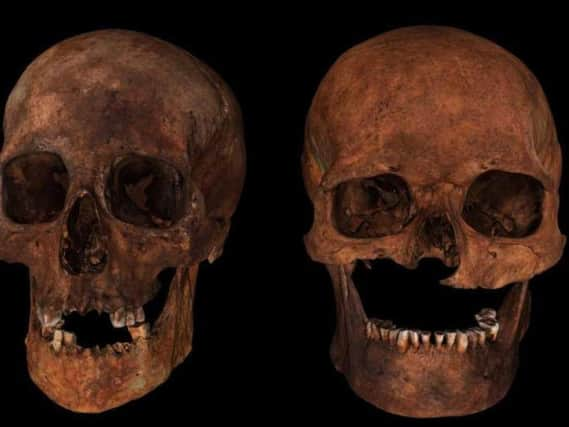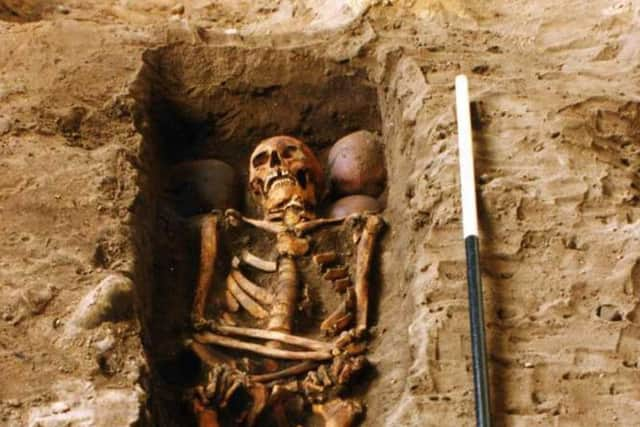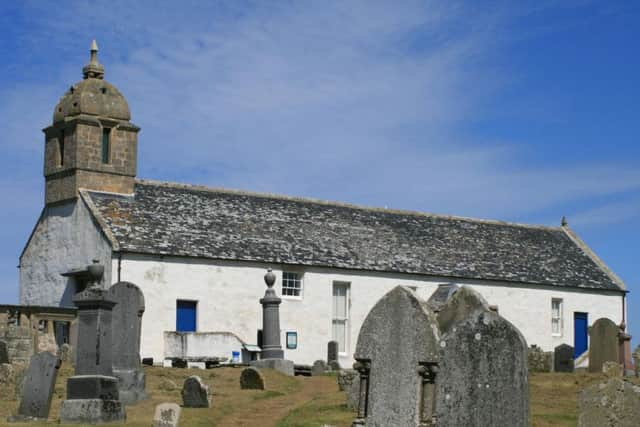'Six-headed burial' of the Highland clan era probed by archaeologists


The remains of two men in their forties were found on top of each other in a single coffin under Tarbat Old Parish Church in Portmahomack, Easter Ross.
One man died from "horrific" sword injuries that removed the bottom half of his face with a second cut found above his left eye.
Advertisement
Hide AdAdvertisement
Hide AdThe second had a blade cut above his left eye with the wound inflicted around the time of death.


Unusually, the skulls of four others had been placed around the bodies in what has been described as a 'special burial'.
The skeletal remains are thought to date from the 15th Century, when Clan Ross and Clan Mackay fought out a terrifying rivalry in the area that arguably peaked with the Battle of Tarbat in the 1480s,
Then, Clan Ross cornered a raiding party of Clan Mackay with many killed in the encounter. Survivors of the attack sought sanctuary in the church, but the Rosses set fire to it, killing all those hiding inside.


Dr Cecily Spall, director of York-based Fieldwork Archaeological Services, has worked at the Portmahomack site over a number of years.
She said the men and skulls were buried in the most prominent part of the church, in the mouth of the crypt directly under the nave.
Dr Spall said: "At this time, burials were incredibly orthodox so this deviates massively from what you would expect to find.
"The Ross and Mackay feud was a very horrible conflict. What we are alluding to is that if these men were not directly linked to these documented events, they are linked to this period.
"What we want to understand is the experience of these men.
Advertisement
Hide AdAdvertisement
Hide Ad"This warrior class could go out an fight for a wage, some of them ended up in Scandinavia as mercenaries, for example.
"Across the Highlands, these finds can make a real contribution to the understanding of these men and how they lived.
"We think we understand Scottish identity but here we have facts on the ground which will help us furnish a more realistic understanding of this time. That is why we are so excited about it."
Dr Spall has been working at the Portmahomack site with Dr Shirley Curtis-Summers of the University of Bradford.
Dr Curtis-Summers, a specialist in human osteology, said: "The injuries suffered by the men suggest they were very, very seasoned fighters."
She added that DNA analysis will help to establish whether these men were related with isotope analysis to offer further insight into the diet of those buried at the site.
The research is set to offer a deeper understanding of clan culture and violence during the medieval era.
More than 170 skeletons, including those of 40 children, have been found under the church with the site spanning five key time periods.
Advertisement
Hide AdAdvertisement
Hide AdIt was first occupied during the 6th to 7th Centuries, when the land was used as a Pictish farmstead. It then became an important Pictish monastery, which was destroyed around 800AD by a Viking raid.
The monastery was replaced and by the 12th Century became a parish church with the final period spanning the 15th to 17th Century.
Dr Curtis-Summers is also researching childhood health and illness in the Highlands using information drawn from the skeletons buried during the later period of the site.
She said: "This site is absolutely vital to our understanding of life in the Highlands. It is one of the few skeletal assets of primary evidence where we have no or very little textual information.
"I would say this skeletal collection at Portmahomack is the Holy Grail of osteology in terms of the resource we have for Pictish lifeways but also to learn about everyday family life in the Highlands."
